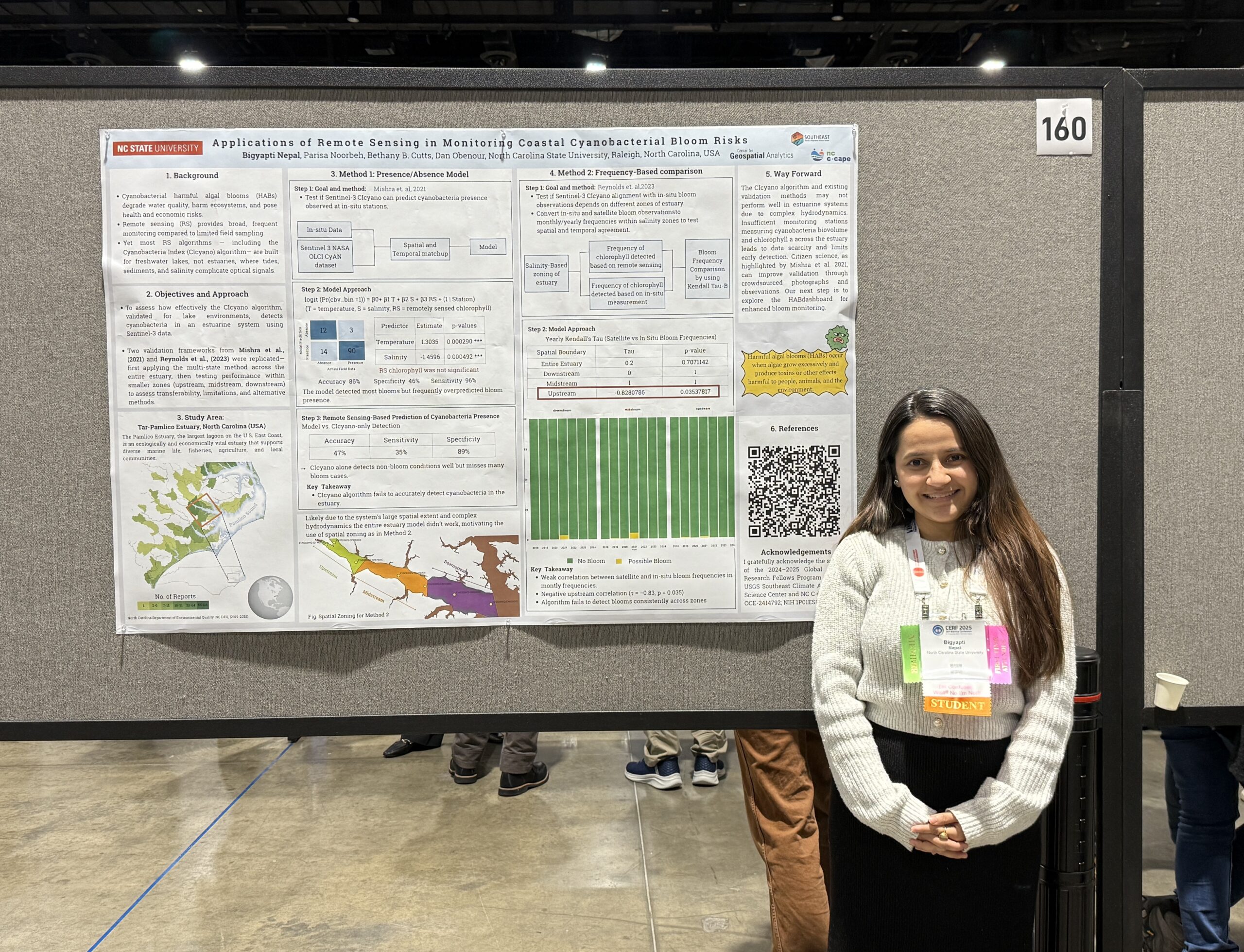Service Learning Projects Drive Spatial Solutions for Public Health, Safety and More

During their final semester, each student in the Center for Geospatial Analytics’ professional master’s program in Geospatial Information Science and Technology (MGIST) applies their knowledge and skills to a client-supplied problem in a service-learning capstone project.
During the Spring 2020 semester, projects ranged from helping Raleigh residents to anticipate flooding on the Greenway and fire departments to find the best places for new fire stations, to supporting public school systems as they assess school crowding, researchers working to identify gaps in access to recreation, investors choosing economic opportunities across the state, state authorities performing essential inspections…and much more!
Read on for a glimpse into the impactful work of our professional master’s students.
Know before you go: flooding on the Greenway

The Capital Area Greenway Trail System comprises over a hundred miles of paths for hiking, biking and more, and Raleigh residents have expressed interest in being able to plan their visits based on real-time trail conditions.
MGIST student Brett Cox partnered with the GIS team at the City of Raleigh’s Department of Parks, Recreation and Cultural Resources and created a prototype web dashboard that uses elevation information and data from stream gauges to predict potential flooding on the trails. The dashboard updates every 15 minutes.
The proof of concept that Cox designed will help the Department to craft their own tool. “I don’t think that this model is accurate enough yet to determine that [an area is definitively] flooded,” he says, “so that’s why I’ve used the terminology ‘potentially flooded.’ I don’t want to make too strong of an assertion.” The current version tends to overestimate flooding, he explains, particularly along Walnut Creek and Crabtree Creek.
The material he provided will allow the Department to “work with and build upon [it] for the future to better deliver services for the citizens of Raleigh,” says Ryan Cooper at the Department.
Siting new fire stations

Fire fighters strive to meet a standard response time of five minutes or less for at least 90% of the emergency calls they receive. As cities grow, homes and businesses sprout up farther and farther away from existing stations, and so new fire stations must be built to reach them in time.
In Knightdale, NC, the population growth rate is double that of Wake County, and “the town is considering adding new fire stations and a possible merger with another station to take on the demand,” MGIST student Adam Blythe explains.
Blythe works for the North Carolina Office of the State Fire Marshall and partnered with the Town of Knightdale’s Fire Department to design a web mapping application that can help the Department make decisions about where to locate new stations. The app features a suitability index, accounting for the density of addresses, drive time and incident density across town. “With very little training, the application user should be able to open up a web browser, use the application to view current fire [response time] suitability, search for new properties [that may be useful locations], run a drive time analysis and assess past incidents,” he explains.
“This project demonstrates how valuable GIS can be when applied to fire response efforts,” Blythe says. “These results have the potential to aid in life-saving decisions…My hope is that this helps Knightdale make some of these decisions but also provides an example to the fire community at large how powerful a tool GIS can be.”
Understanding school capacity and demographics

With almost 200 schools to manage, the Wake County Public School System (WCPSS) faces myriad decisions about student placement and system-wide planning. “There’s a steady stream of data that flows through the [WCPSS] Office of Student Assignment,” says MGIST student and former schoolteacher Sadie Barker. To explore what those data can reveal, she partnered with WCPSS to map enrollment across the county and even within the schools themselves.
Barker created an interactive web dashboard that lets officials examine school capacity system-wide, and she built a 3D model of Athens Drive Magnet High School, to provide an even deeper glimpse into the student experience.
A student at the school who is interested in GIS worked with Barker to digitize the building plans and share his first-hand knowledge about the school layout. “These are the kinds of partnerships that are…being done to connect K-12 public education with the university system, like the GAPS program at NC State and the 4-H Chapter, which is how [the student] and I first got connected,” Barker says.
“The Office of Student Assignment could use a [3D] model like this to display information similar to…the [system-wide] dashboard,” she explains, “but on a room-by-room basis rather than school-by-school. So you could click on a point and see the demographics of the students assigned to that exact room.” Her model also enables finding optimal routes within the building, allowing planners to ask data-driven questions such as: “Where could we place an elective based on where students were in the building in the period prior to that?” she says.
“I really enjoyed being a part of this project and just kind of cracking the door open to what was possible with this information,” Barker says.
Her WCPSS contact, Rob Siwiec, expects Barker’s creations to “improve the way we work and share data at the district and our office, and hopefully these prototypes will keep us busy for years to come.”
Finding recreational opportunity access gaps

Across the state of North Carolina, recreational opportunities abound, but not equally. “Just because there’s a recreational site nearby does not mean a low-income family as access” to it, explains MGIST student Christine Pilato. Pilato partnered with Kyle Bunds, assistant professor in the Department of Parks, Recreation and Tourism Management at NC State, to map the locations of recreational opportunities in the state and delve into the spatial aspects of inequity.
“Your analysis is only as good as your data,” Pilato says. “You have to be mindful of who is counted and who is not,” and so she manually searched for, identified and geocoded myriad recreational sites––like parks, rec centers, health clubs, gyms and public pools––across the state. She then used all of this information to build a web mapping application that shows sites’ locations as well as surrounding demographics and areas lacking recreational sites within a 15- or 30-minute drive.
“Given Dr. Bunds’ department’s work with external stakeholders, the goal was to create an application that was both exploratory and actionable,” she says. “We already have an understanding that there might be shortage areas in North Carolina, but where can we best effect change?” Her analyses revealed that in several NC counties, “the shortage areas…predominantly affect non-white communities and in particular the black population.” She also found that “communities that are most impacted by shortage gaps are generally more rural, older and impoverished.”
Viewing this data spatially can help planners understand where access to opportunities is needed most. Says Bunds, Pilato’s hard work yielded “everything we could have hoped for and more” to advance the research.
Investing in distressed regions to grow economic prosperity

For communities suffering economically, being designated an Opportunity Zone by the Internal Revenue Service opens up possibilities to attract more investment. According to the IRS, these “zones are designed to spur economic development and job creation in distressed communities…by providing tax benefits to investors who invest eligible capital into these communities.”
Making investors aware of these zones is therefore important to spurring their recovery. MGIST student Jim Albert partnered with the company SpatialGIS to map the locations of North Carolina’s 252 Opportunity Zones and provide associated information about demographics and parcel values in a web mapping application.
The main aim was to produce “an application that investors can use to query and assess Opportunity Zones within the entire state of North Carolina,” Albert says, “to help develop investment and interest in these opportunities. This matters because promoting these Opportunity Zones is not just a way to mitigate an investor’s tax burden; it’s also an excellent way to help distressed areas invigorate business opportunities and enrich the lives of the people that live in them.”
Performing paperless inspections

One hallmark of GIS is its ability to streamline everyday tasks, making them more efficient and effective. Multiple MGIST capstone projects this semester focused on enabling state authorities (including their own employers!) to better manage and inspect important infrastructure, and help them finally go paperless.
Matthew Cobb partnered with the Stormwater Management Division of NC State University’s Office of Environmental Health and Safety, developing a digital, spatial way for them to “track and prioritize inspections and maintenance” of stormwater control measures (SCMs) meant to “capture, retain and improve the quality of stormwater runoff,” Cobb explains. “They remove pollutants, provide flood control and reduce downstream erosion. These SCMs must be inspected and maintained by the University” to meet compliance with permits, and so Cobb devised a way for NC State staff to digitally collect data in the field and integrate it with a web-based dashboard that can help them manage and prioritize inspections.
In the Town of Apex, NC, James Wheaton is the Department of Public Works’ GIS specialist; to help his employer track tasks like mowing near water and sewer mains, sidewalks and guardrails, he created a web mapping application that integrates with the Department’s existing software. The new workflow he created allows Public Works staff to map and store data about maintenance work and even automatically create work orders. The old method was time-consuming and relied on a lot of manual steps that could introduce errors, Wheaton explains; the new GIS-based system will save time for field crews and office staff, including himself.
Alli Jones is the GIS Applications Programmer for Cumberland County, NC, and her capstone project too “tied directly into my daily work,” she says. Until this semester, all of the information about the county’s thousands of wells and septic systems existed “only on paper forms and plot plans,” Jones explains. The county’s three Environmental Health Inspectors must regularly visit these systems, to inspect them, recommend repairs or determine sites for new ones, and so a digital method was needed to “view, edit and create data for wells and septic systems in the county,” Jones says. To meet this need, she created a geodatabase editable by inspectors and GIS staff and a web mapping application that can be synced with data gathered on mobile devices. “This project is a proof of concept,” Jones says, “but is fully functional for Cumberland County…The project methods were designed based on current county operations and procedures, making it easier for integration for county employees.”
The federal Land and Water Conservation Fund (LWCF) has helped protect valuable natural resources across the country, and in North Carolina the program has “provided over $85 million in matching funds to protect land and support over 900 state and local park projects,” explains Charlie Charping. Projects funded by LWCF awards must be regularly inspected to track their progress, and so Charping partnered with the Recreation Resources Service and North Carolina State Parks to create GIS tools that allow regional and local staff to see where inspections will soon be due, prioritize inspections spatially and collect information in the field. “A strong emphasis was on mobile data collection and helping the clients move away from paper forms,” Charping says, “putting the spatial component at the center of the problem.”
And more!
Several MGIST capstones expanded on the work of students in previous semesters: Kelsey Little built on the work of a May 2019 graduate, partnering with the nonprofit organization Clean Jordan Lake to help them assess patterns in trash accumulation on the Jordan Lake shoreline after rainstorms. Martine Kamabu partnered with the North Carolina Wildlife Resources Commission (NCWRC), following up on work from December 2019 to build a web mapping application that will help the agency track changes in public access to private lands participating in the Public Mountain Trout Waters program.
Several more students worked with researchers and faculty at NC State:
Anja Collette partnered with Stacy Supak, associate teaching professor at the Center for Geospatial Analytics, to create a web mapping application that will help federal land managers visualize the geospatial demand for overnight accommodations at national parks and other federal lands.
Sarah Shefte worked with Erin Sills, professor in the Department of Forestry and Environmental Resources, as part of a five-year, multi-institution research project examining energy poverty in southern Africa; the web mapping application Shefte built identifies the locations of charcoal markets in Lusaka, Zambia, and will help researchers better understand energy purchasing decisions in the region.

In partnership with Jean Ristaino, professor in the Department of Entomology and Plant Pathology, Xingli Ma developed a web mapping application that will help researchers track the occurrence and spread of the agricultural pathogen that causes late blight in potato and tomato crops.
Working with Frederico Freitas, assistant professor in the Department of History, Samuel Franklin used five decades of satellite imagery to create a story map that tracks changes in land use in Brazil before and after the construction of the Federal District in Brasilia in the mid-20th century.
Additional projects supported industry, government agencies and nonprofit groups to further their missions:

Working with the US Fish and Wildlife Service, Victor Dawson created an open source tool to help manage habitat for the federally endangered red-cockaded woodpecker at Fort Bragg, North Carolina. The interface he designed with QGIS will allow users to calculate habitat suitability, determine what timber management is required to create suitable habitat and help mitigate the impacts of proposed activities on the species.
Justin Castrati built a web mapping application than can help the National Park Service plan future walking trails at Overmountain Victory National Historic Trail, which traces a 330-mile route taken by American troops during the Revolutionary War.
Todd Kesselring partnered with the North Carolina Office of State Budget and Management to help them better understand the makeup of different geospatial regions used by state agencies to conduct their operations.

In collaboration with the North Carolina chapter of The Nature Conservancy, Jennifer Parra-MacDougal performed analyses and created geoprocessing tools to identify areas of forestland of high priority to protect from potential solar development.
Lucian Stewart partnered with the US Geological Survey to create a toolbox of automated methods that will help ensure the quality of a forthcoming high-resolution dataset called Elevation-derived Hydrography, which will support numerous mapping and modeling efforts concerned with the nation’s streams and other waterbodies. He created a story map to serve as “a promotional resource for all of the stakeholders of USGS,” he explains, “to understand what’s going on behind the scenes to produce this important dataset.”
Matthew Johnson worked with the North Carolina Department of Environmental Quality’s Division of Coastal Management to create a web mapping application that explores wildfire risk and fire breaks in the unique maritime forest of Buxton Woods Coastal Reserve.
Thank you to all of our capstone partners, and congratulations to all of our graduating MGIST students on their success!


